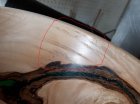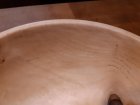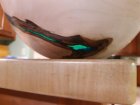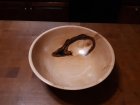Looking for a little troubleshooting help on this ambrosia maple bowl that I am finishing. I am getting rough spots in the grain on the inside of the bowl. I used my negative rake scraper on the inside before sanding. I thought sanding would remove the rough spots which didn't feel that bad. I went through sanding grits 100, 120, 150, 180, 220, 280, 320, 400 and 600 with my right angle drill. I put some Myland's friction polish on and it just seemed to accentuate the rough spots. The bowl is 1/4 to 5/16 thick right now.
I am not sure if I am picking up vibration or if this is just in the grain. I did a thicker and smaller bowl from the same tree and it turned out very smooth. I don't have a bowl steady rest. I did use my finger on the outside while negative rake scraping. The inside does have some slight ripples so I know that I have some vibration. I did try varying the speed while scraping from 1000 to 1800 rpm.
Should I go back in there with my negative rake scraper with a fresh sharpening and keep practicing until I get it smooth? Or go back to sanding? Can ambrosia maple be troublesome? I did use a little water in the bottom while scraping and that helped in the bottom, maybe a little water on the sides will do the trick.
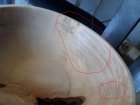

I am not sure if I am picking up vibration or if this is just in the grain. I did a thicker and smaller bowl from the same tree and it turned out very smooth. I don't have a bowl steady rest. I did use my finger on the outside while negative rake scraping. The inside does have some slight ripples so I know that I have some vibration. I did try varying the speed while scraping from 1000 to 1800 rpm.
Should I go back in there with my negative rake scraper with a fresh sharpening and keep practicing until I get it smooth? Or go back to sanding? Can ambrosia maple be troublesome? I did use a little water in the bottom while scraping and that helped in the bottom, maybe a little water on the sides will do the trick.



